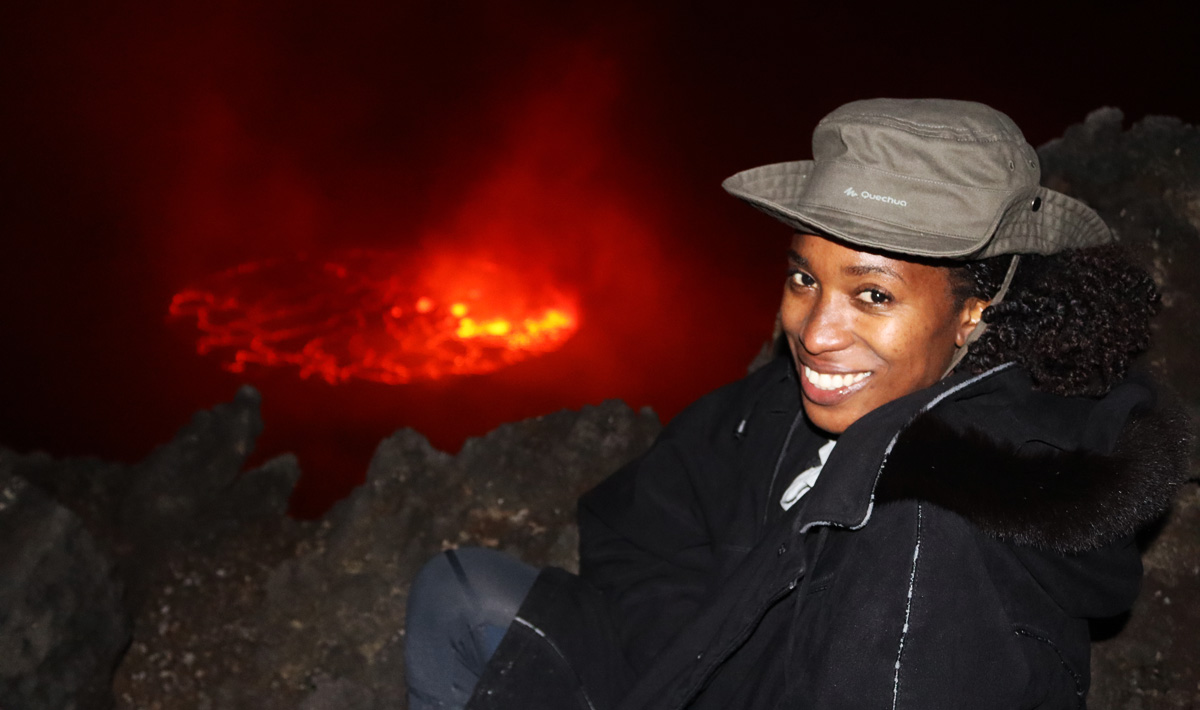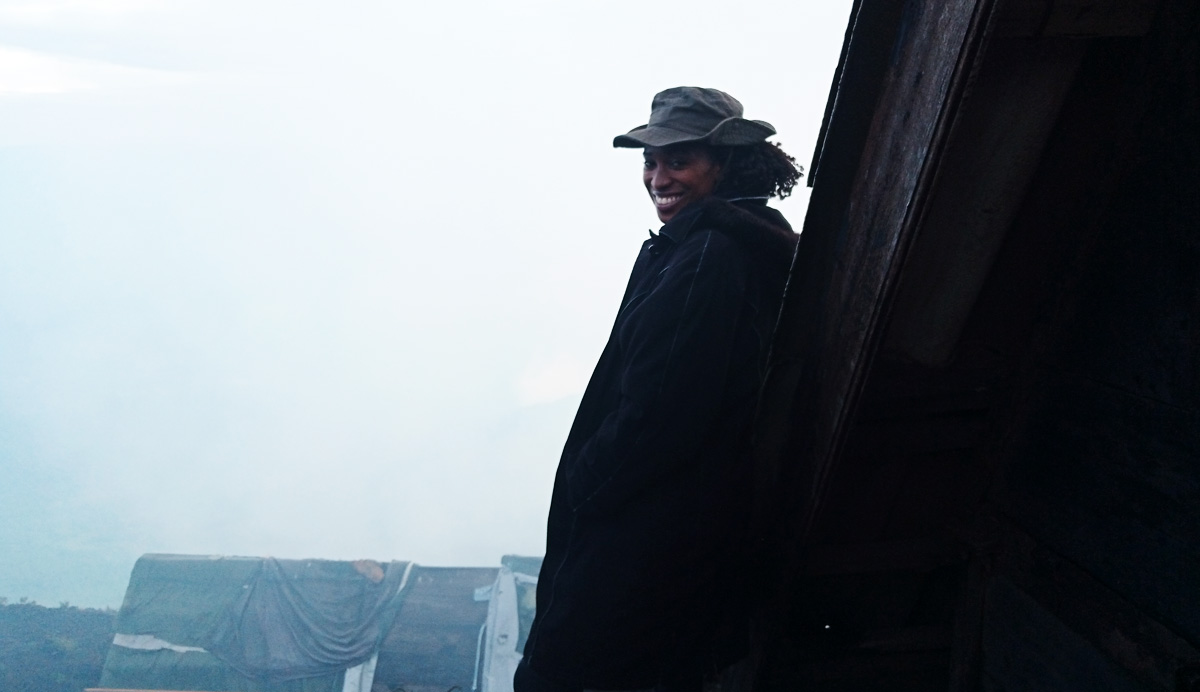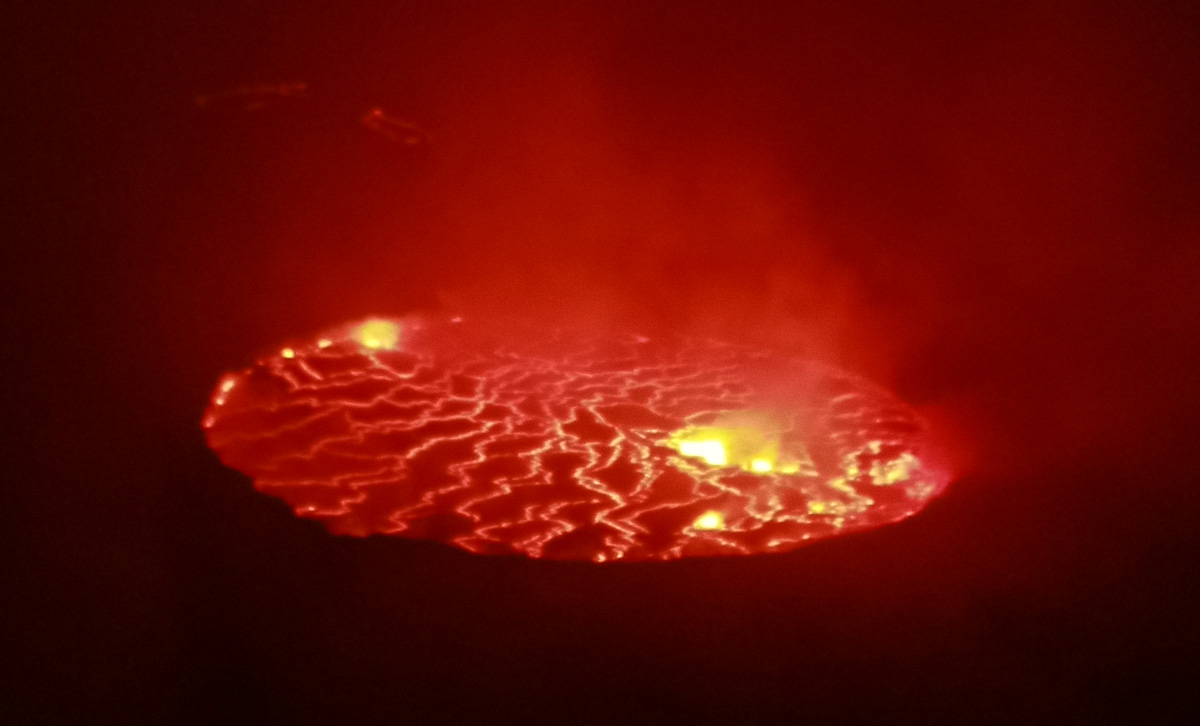 The bus ride from Kampala to Gisenyi was rather long and hectic, the Congolese lady seated in front of me was giving me such a hard time with her seat. She kept on pushing it backwards with no consideration for my long legs and the effect it would have on my knees. After a few back and forth arguments with her in Swahili, I gave up and decided to gaze out of the window into the dark. I was anxious to see the boiling lava of the Nyiragongo and was so grateful that this trip was finally happening after two previously failed attempts. I have always been compelled by Mount Nyiragongo; an active stratovolcano with an elevation of 3,470m with the world’s largest Lava Lake visibly sighted from the crater rim at the summit point.
The bus ride from Kampala to Gisenyi was rather long and hectic, the Congolese lady seated in front of me was giving me such a hard time with her seat. She kept on pushing it backwards with no consideration for my long legs and the effect it would have on my knees. After a few back and forth arguments with her in Swahili, I gave up and decided to gaze out of the window into the dark. I was anxious to see the boiling lava of the Nyiragongo and was so grateful that this trip was finally happening after two previously failed attempts. I have always been compelled by Mount Nyiragongo; an active stratovolcano with an elevation of 3,470m with the world’s largest Lava Lake visibly sighted from the crater rim at the summit point.
I was relieved when the bus finally halted at the Gisenyi bus station, it had been an exciting journey at the start but a bit grueling in the end after sitting for almost 12 hours. It was interesting to jump on a motor bike and, in my limited French, bargain for a ride to the Paradise Malahide Hotel where I was staying for the night. The service at the hotel was incredible, I was warmly welcomed by the staff especially since I’m a Travel consultant at Matoke Tours; one of the leading Tour agencies in East Africa that gives them plenty of business. The food was great and the views of Lake Kivu were quite fascinating. I was particularly impressed by a group of fishermen who lowered their canoes into the water and set off chanting and singing songs simultaneously as they rowed across the water. The staff at the Malahide informed me that the best time to go angling was from 6PM-6AM.
The border entry organized by both immigration and health officials at the Grand Barrier border post the following morning was exceptional. I was attempting to enter Congo and was amazed by how well the system worked at both the entry and exit points. The officials were quite warm and friendly to start with, and they thoroughly checked through every passenger’s travel documentations, health certificates and even went ahead to measure our body temperatures. The Virunga Office at the border post is where most tourists coming to visit Virunga check in to get their Gorilla or Mountain hike permits, these are meant to be showcased at the National Park before the start of the hike.
As soon as the checks were done, by 8 am, about 15 of us sat on the Virunga National Park truck and were drove towards the Kibati Patrol post which is about 1.5 -2hrs away from the Grand Barrier border. There was a heavy traffic flow in Goma town that morning with so many commuters seated on motorbikes heading to various parts of the city. The buildings in and around the city looked old and dilapidated. Political instability in this region in recent years has greatly hindered the growth and development of the town. Excited children waved at us and tried their best to greet us in English as the truck was mainly occupied by Caucasians.
 The hike started at about 10:30am after the briefing process and allocation of a porter to each individual. The trails at the start were quite muddy from the rains of the previous day but quite comfortable to walk through. The ascent eventually got steeper and tiring, hiking through the Lava rocks became difficult but we all got to the summit point safe and sound. The trek, which lasts for an average of 5-6hours is done at a moderate pace to enable even slow and relatively unfit hikers to get to the summit point. The rangers are quite helpful and have interesting stories about Goma and Congo to share with the hikers along the way. This also might be a polite way for them to distract the group from the tough terrain experience, especially at the final segment during the ascent to the crater rim.
The hike started at about 10:30am after the briefing process and allocation of a porter to each individual. The trails at the start were quite muddy from the rains of the previous day but quite comfortable to walk through. The ascent eventually got steeper and tiring, hiking through the Lava rocks became difficult but we all got to the summit point safe and sound. The trek, which lasts for an average of 5-6hours is done at a moderate pace to enable even slow and relatively unfit hikers to get to the summit point. The rangers are quite helpful and have interesting stories about Goma and Congo to share with the hikers along the way. This also might be a polite way for them to distract the group from the tough terrain experience, especially at the final segment during the ascent to the crater rim.
A very fit French guy called Vincent and a lovely Norwegian girl –Maren and I were the first to get to the top, with my years of mountain hiking experience and regular exercise helping me to get there first! The three of us quickly rushed to our huts which were quite cosy with mattresses and pillows inside. This was the best accommodation facility I ever had in any of my mountain expeditions. The cold at the summit point was unbearable with the clothes we arrived in; so extra layers of warm clothes, socks and gloves proved to be very handy. I was pleased to see the rest of the group join us at the crater rim after about 40 minutes. We all re-united and stood at the edge of the massive crater filled with red bubbling lava –an out of this world experience and one of the biggest life highlights for all of us.
We were served warm cups of coffee and tea by our special Virunga chef, and later had deliciously prepared chicken, rice and vegetables for dinner accompanied with pineapples for dessert. The faint roars of the volcano could easily be heard from the mattresses on the floor of our designated huts, this prompted most of us to get up in the middle of the night and stare into the bubbling cauldron of fire, one of the most incredible natural phenomenon one could ever witness. Plenty of pictures and videos were captured by all of us- I had about 420 pictures on my phone, that’s how obsessed I was with the scenery!
We managed to fall asleep and woke up to freshly made coffee and tea, sausages, eggs, toast and fruit. The five star service we received during this entire trip was one we would never forget, it was unbelievable but worth the USD 300 we paid for the hiking permit. Our descent back to the starting point begun at about 7am, it was a bit of a struggle to walk through the loose volcanic rocks without tripping to the ground but thankfully none of us was injured.
 We were back on ground by 10am, generously tipped our devoted porters, rangers and the entire crew that effortlessly took good care of us. We had a few grievances centered around the trip organization that we shared with the park authorities and later boarded the truck back to the Grand Barrier border, into Gisenyi and to our various hotel rooms. I went to bed happy that I had that amazing adventure ticked off my bucket list.
We were back on ground by 10am, generously tipped our devoted porters, rangers and the entire crew that effortlessly took good care of us. We had a few grievances centered around the trip organization that we shared with the park authorities and later boarded the truck back to the Grand Barrier border, into Gisenyi and to our various hotel rooms. I went to bed happy that I had that amazing adventure ticked off my bucket list.
The following is essential for the hike:
- Quality hiking boots
- A Quality back pack
- A hand watch
- Sun-glasses
- A long pair of thick socks
- Long sleeved pants and shirts (to act as protection from thorn pricks from the bushes along the hiking trails).
- Sunscreen for skin protection (the heat in this region tends to be extreme especially between December-February).
- A hat or cap to offer protection from the hot sun.
- Oranges for vitamin c, chocolate bars and salty snacks are also handy to replace the nutrients lost during the hike.
- Altitude sickness tablets like Diamox and Acetazolamide come in handy for hikers who suffer from Altitude sickness. Medication is best when taken a day before the hike or at the start of the hike.
- A sleeping bag, a tent, and all the necessary beddings required. (if hiker’s choose to spend a night at the mountain)
- A head torch comes in handy especially in the night.
- A camera/phone camera to capture the breath taking views encountered during the hike.
- A fully charged power bank to re-charge one’s phone comes in very handy.
- Toilet paper/wet wipes/hand sanitizer/face towel/Tooth paste & brush- Hikers should not expect to have a bath/shower at the mountain.





